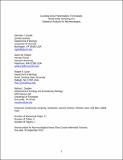| dc.contributor.author | Gotelli, Nicholas J. | |
| dc.contributor.author | Ellison, Aaron M. | |
| dc.contributor.author | Dunn, Robert R. | |
| dc.contributor.author | Sanders, Nathan J. | |
| dc.date.accessioned | 2011-01-06T18:30:13Z | |
| dc.date.issued | 2011 | |
| dc.identifier.citation | Gotelli, Nicholas J., Aaron M. Ellison, Robert R. Dunn, and Nathan J. Sanders. Forthcoming. Counting ants (Hymenoptera: Formicidae): Biodiversity sampling and statistical analysis for myrmecologists. Myrmecological News 15:13-19. | en_US |
| dc.identifier.issn | 1994-4136 | en_US |
| dc.identifier.issn | 1997-3500 | en_US |
| dc.identifier.uri | http://nrs.harvard.edu/urn-3:HUL.InstRepos:4645910 | |
| dc.description.abstract | Biodiversity sampling is labor intensive and is especially challenging for myrmecologists, because the sampling units (individual workers) do not correspond in a simple way to the natural units of diversity (individual nests). Because it is usually not possible to reach a sampling asymptote for ants, comparisons of species richness among collections have to be carefully standardized for the number of individuals and number of samples examined. Asymptotic estimators allow for extrapolation to an estimated asymptote of species richness, and rarefaction curves permit meaningful comparisons of samples by interpolating data to a standardized number of sampling units.
Winkler sacks of leaf litter and specialized traps for arboreal ants often yield distinctive sets of species in tropical and subtropical latitudes. These microhabitats are best treated as distinctive assemblages that can be compared with stratified sampling. Within other habitat types, different baiting and sampling methods yield similar, but not identical sets of species, and many authors have advocated using a diversity of methods to gain the greatest coverage of species. However, many of the distinctive species that are sampled by a particular method are rare, and are just as likely to have been found with other sampling methods. The estimated similarity in composition of ants sampled by different methods in the same habitat is probably more similar than has been appreciated. Recent published comparisons of sampling efficiency have shown that hand-collecting accumulates species more efficiently than the more commonly used pitfall traps or baits. However, if hand-collected samples are to be analyzed quantitatively, hand-sampling must be standardized to a constant plot size that is searched for a fixed amount of time, and all nests encountered must be sampled and counted. For comparative studies of ant assemblages across habitats, hand collecting may be superior to either litter sampling or pitfall traps because it can be used in sites that have no leaf litter or are too environmentally sensitive, too rocky, too steep, or contain too much human and domestic animal traffic for pitfall trapping. Data from hand-sampling and grids of pitfall traps lend themselves to slightly different kinds of analyses. Hand sampling probably gives the best estimates of the true frequency of nests of different species in an area, and the data can be used with individual-based rarefaction curves and many standard parametric statistical tests. Data from pitfall trap grids should usually be treated as sample-based occurrences, and analyzed with sample-based rarefaction and diversity estimators. For the purposes of estimating diversity, myrmecologists should avoid the temptation to analyze the underlying counts of individual workers. Data from replicated grids of pitfall traps can be analyzed with hierarchical occupancy models. These newly developed models provide useful estimates of probabilities of occurrence and probabilities of detection for each species in the assemblage. Biogeographic patterns of ant diversity, such as latitudinal gradients of species richness, are comparable to those seen in other taxa, and the data collected by myrmecologists can contribute in important ways to our general understanding of biodiversity patterns. | en_US |
| dc.description.sponsorship | Organismic and Evolutionary Biology | en_US |
| dc.description.sponsorship | Other Research Unit | en_US |
| dc.language.iso | en_US | en_US |
| dc.publisher | Austrian Society of Entomofaunistics | en_US |
| dc.relation.isversionof | http://myrmecologicalnews.org/cms/ | en_US |
| dash.license | OAP | |
| dc.subject | biodiversity sampling | en_US |
| dc.subject | species richness | en_US |
| dc.subject | rarefaction | en_US |
| dc.subject | Winkler sacks | en_US |
| dc.subject | leaf litter | en_US |
| dc.subject | pitfall traps | en_US |
| dc.title | Counting Ants (Hymenoptera: Formicidae): Biodiversity Sampling and Statistical Analysis for Myrmecologists | en_US |
| dc.type | Journal Article | en_US |
| dc.description.version | Accepted Manuscript | en_US |
| dc.relation.journal | Myrmecological News | en_US |
| dash.depositing.author | Ellison, Aaron M. | |
| dc.date.available | 2011-01-06T18:30:13Z | |
| dash.contributor.affiliated | Ellison, Aaron | |


